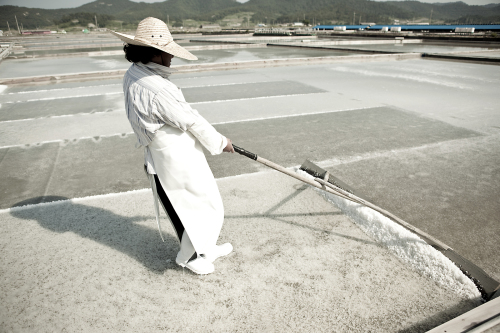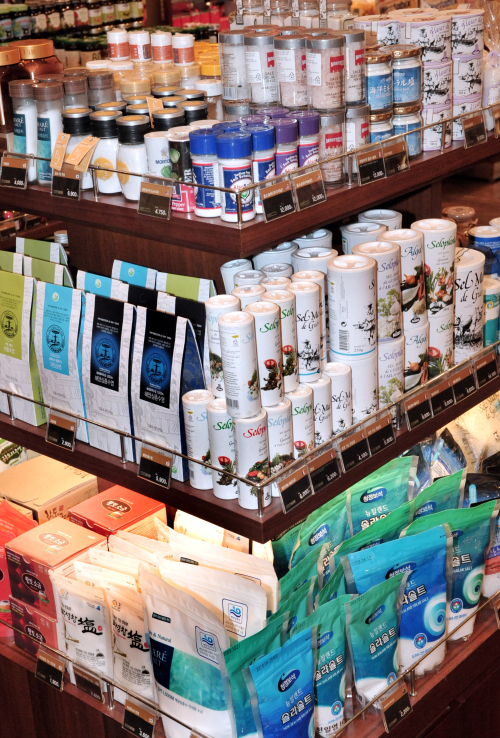Premium minerals sought out by health-conscious consumersAt Anzu, a Seoul-based Japanese tonkatsu restaurant, salt plays a crucial role.
Generally an invisible entity that we take for granted, the edible rock arrives in vivid green and golden hues alongside the establishment’s fried vegetables. Powder fine, one tastes of green tea, the other of curry.
For their tonkatsu (breaded pork cutlet), the informative waiting staff recommends dipping each thick, tender slice in the freshly ground orbs of sodium chloride.
“The salt enhances the soft textures of the pork,” Anzu captain Park Sung-yoon, 29, said.
Of the emerald and ochre versions, he said, “The curry salt brings out the natural flavors of the vegetables, while the green tea rids them of any unpleasant odors.”

Soltree’s salt is gathered with a huge wooden paddle-like instrument from the natural mudflat foundation where it is harvested in Sineui Island, Sinan County. (Soltree)
Anzu is so selective about which mineral they use that they use separate varieties for the vegetables and the pork. Furthermore, the establishment eschews sea salt in favor of rock salt, because “we work with food that comes from the land so we use land-based salt.”
A firm believer in the age-old seasoning as a chameleon-like specimen endowed with a boundless array of flavors, Park views salt as infinite territory.
One trip to Shinsegae Department Store’s luxurious Gangnam branch proves him right.
An entire pyramid of salt ― up to 72 varieties ― occupies a whole corner of Shinsegae’s Premium Grocery.
Himalayan pink salt, the famed French Sel de Guerande and other minerals hailing from New Zealand, Australia and South Korea line the shelves. There are even beauty salts on display.
While it has only been about a year since this corner sprung up, said food team grocery PC employee An Ji-young, the large supermarket on the other side has had its three rows worth of 39 kinds of primarily domestic salt for quite some time now.
Clearly, shoppers care about their sodium chloride, and, according to supermarket cooperative employee Park Eun-suk, they like it high-end.
Park, 33, pinpointed South Korean brand The Salt’s Premium Solar Sea Salt and The Natural Solar Sea Salt as popular items in the main supermarket section.
“It is rich in minerals,” she described the Premium Solar Sea Salt, which is harvested from mudflats in South Korea’s Sineui Island, Shinan County. “So it is good for your health. It also has a slightly sweet taste.”
“Good salt should have a hint of sweetness,” she explained.
Another hit variety, Chungjungwon’s Aged for Three Years Solar Salt, also hails from Shinan County ― which Park named the current “it” place for salt.
According to the official English website for Shinan County (eng.shinan.go.kr), salt from the area boasts a relatively high mineral content and is good for one’s health by aiding digestion, speeding up one’s metabolism and by keeping blood vessels clean.
“The mudflats in that area are unpolluted, so we decided to sell salt from there,” said Soltree marketing and PR general manager Oh Sang-yon.
Just three months ago, Soltree ― a brand of high quality salt also produced in Sineui Island ― was launched.
Like The Salt’s Premium Solar Sea Salt, Soltree’s salt is harvested from “topan.”
“Topan,” according to Oh, refers to a natural salt-producing foundation made from the mudflat itself as opposed to ones made from synthetic materials.
In short, Soltree wants everything to be as clean and eco-friendly as possible, a tack that is in keeping with their target consumer ― health-conscious, cooking aficionados and housewives in their late 20s to early 40s.

At Shinsegae Department Store’s Gangnam Branch an entire pyramid of salt of up to 72 varieties awaits consumers at the Premium Grocery area on the basement floor. (Chung Hee-cho/The Korea Herald)
Plans are to take their sleekly-packaged brand abroad and put it right up there next to other world famous salts like France’s Sel de Guerande, which is currently enjoying popularity in Shinsegae Gangnam’s Premium Grocery area.
“Guerande table salt also sells well,” said cooperative employee Kim Yeun-suk, 42, who picked The Salt’s Premium Solar Sea Salt and South Korean brand BioSalt (which specializes in sun-dried salt that has been baked for 13 hours in an ocher pot) as other hit products in the Premium Grocery’s salt corner.
Even in a section that boasts an international selection of high quality salt, two out of three popular brands that Kim mentioned are South Korean, and it is not because they are cheaper.
One kilogram of The Salt’s Premium Solar Sea Salt costs 38,000 won at Shinsegae, over 14,000 won more than what one kilogram of Guerande table salt (250 grams is priced at 5,800 won) would cost.
Despite that, Shinsegae’s Park said some customers will go so far as to plunk down good money to use the Premium Solar Sea Salt for kimchi and fermented pastes.
Within South Korea alone, the varieties of salt are endless, with pine pollen salt ― produced by the scattering of the pollen over Taean Peninsula salt ponds in May ― currently being produced.
It may be too early to call consumer interest in high quality salt a booming trend, but there are signs that it could happen soon.
Soltree’s Oh said, “I cannot feel the market for premium salt expanding yet, per se, but I think you could say it is just beginning.”
● The Salt, www.thesalt.co.kr, (031) 211-6778
● Soltree, www.soltree.com, (02) 1544-7644
● BioSalt, www.biosalt.net, (02) 572-0091
By Jean Oh (
oh_jean@heraldcorp.com)







![[Graphic News] More Koreans say they plan long-distance trips this year](http://res.heraldm.com/phpwas/restmb_idxmake.php?idx=645&simg=/content/image/2024/04/17/20240417050828_0.gif&u=)